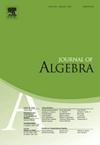具有有限多个非正规子群同构类的群
IF 0.8
2区 数学
Q2 MATHEMATICS
引用次数: 0
摘要
如果H和Hg对G的每个元素G在< H,Hg >中共轭,则群G的子群H被称为正态群。有限或无限群中的正态子群的行为经常被研究,特别是所有子群都是正态的(广义)可溶群的结构是已知的。本文证明了任何非正规子群落入有限多个同构类的(广义)可溶群要么是极小极大群,要么是所有子群都正规的群。本文章由计算机程序翻译,如有差异,请以英文原文为准。
Groups with finitely many isomorphism classes of non-pronormal subgroups
A subgroup H of a group G is said to be pronormal if H and are conjugate in for every element g of G. The behaviour of pronormal subgroups in finite or infinite groups has been often investigated and, in particular, the structure of (generalized) soluble groups in which all subgroups are pronormal is known. Here it is proved that any (generalized) soluble group in which non-pronormal subgroups fall into finitely many isomorphism classes either is minimax or a group in which all subgroups are pronormal.
求助全文
通过发布文献求助,成功后即可免费获取论文全文。
去求助
来源期刊

Journal of Algebra
数学-数学
CiteScore
1.50
自引率
22.20%
发文量
414
审稿时长
2-4 weeks
期刊介绍:
The Journal of Algebra is a leading international journal and publishes papers that demonstrate high quality research results in algebra and related computational aspects. Only the very best and most interesting papers are to be considered for publication in the journal. With this in mind, it is important that the contribution offer a substantial result that will have a lasting effect upon the field. The journal also seeks work that presents innovative techniques that offer promising results for future research.
 求助内容:
求助内容: 应助结果提醒方式:
应助结果提醒方式:


